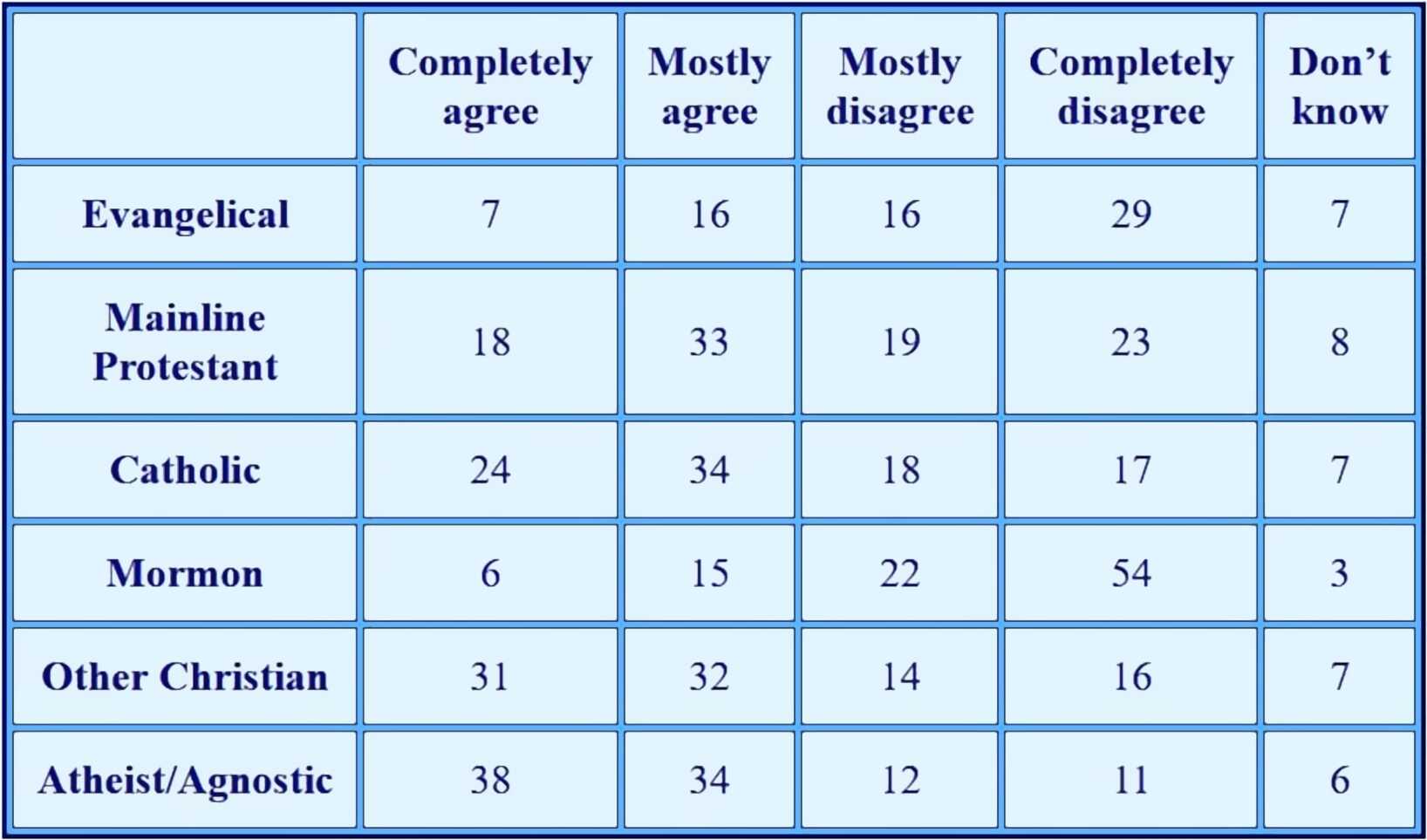Chapter 2
Types of Creationism
Humanism vs. Christianity
The Polarization of America
by Patrick Vosse

Living Water at Christianity Oasis
John 7:38 He that believeth on me, as the scripture hath said,
out of his belly shall flow rivers of living water.

Part One
Evolution vs. Creationism
Chapter 2 - Types of Creationism
Most Christians, but not all, believe that God created everything that exists and there is no such thing as evolution in the development of organisms. Within the concept of God the Creator, there are several different philosophies. Martin Luther preached the young earth creation theology that holds to a literal 6-day creation process as presented in Genesis. The Catholic Church accepts evolution (albeit with some divine oversight). In other words, not all Creationists are created equal. This chapter is devoted to the discussion of the various approaches to Creationism. Table 1 summarizes the position taken by several Christian traditions regarding evolution.
Table 1. Responses to the question: "Do you agree that evolution is the best explanation for the origins of human life on earth?"[1]

The Pew survey indicates that Christians are not in agreement regarding the basic question: Creation or evolution. Prior to Darwin, this was not a polarizing issue within the Christian community. Today, the arguments about creation and evolution can be just as heated within the Christian community as between Christians and Humanists.
Prior to Darwinian evolution, the literal interpretation of the Genesis account was the general consensus. Eventually the scientific community and the general public began to accept the idea of evolution. As discussed later in the book, the argument began to get serious when evolution by natural selection, i.e. without divine intervention, was taught in the public schools. Discoveries in biology, geology, and physics presented evidence that contradicted the literal interpretation of the creation story. With this growing evidence, many theologians considered modifying their interpretation of creation. Some of these interpretations agree with Scripture, some do not. Some agree with scientific evidence, some do not. However, one thing is certain, evolution not only caused polarization between Creationists and Evolutionists, it caused polarization among Christians. In this chapter, we will discuss the major positions on Creationism.
One-Time Creation
A few of the more liberal Creationists hold that God created matter with its inherent laws of governance, then "let nature take its course." They allow for a theistic cause for the universe, but do not include any divine intervention after the initial creative act. This position allows for non-theistic evolution. This is on the fringe of Christian belief and more appropriately associated with the Deist position as well as some non-Christian religions and Gnosticism. Virtually no one considering the theology or the science of creation/evolution accepts this position. It does not agree with the numerous scriptures that declare a personal God involved with everything, particularly humanity. Evolutionist and Humanist reject it because it proposes a divine initiator and Humanism rejects anything spiritual as an explanation for anything. At the other extreme are the Young Earth Creationists.
Young Earth Creationism
Young-earth Creationism adheres to a literal interpretation of the Bible and that the earth was created within the last ten thousand years. Approximately 40 percent of Americans believe in the young earth creation theology, but that number is declining. This time frame is established from genealogical accounts given in the Bible. Young-earth Creationists believe that the universe is approximate the same age as the earth. The apparent age of fossils and geological structures are accounted for by God creating them to appear old. Most young-earth Creationists believe that God created the earth in a literal 6-day period. Fundamental to the young-earth theology is that there is no macroevolution,[2] i.e. one species evolves into a new and different species.
This interpretation is similar to what the nomadic Hebrews believed a simple literal acceptance of the biblical statements. Whereas the early Hebrews had no scientific facts to challenge the literal interpretation, modern-day literalists do. However, they explain them away or, in some cases, simply ignore them. However, this form of Creationism has some problems that the Evolutionists are pleased to point out.
Internal contradictions within the Genesis account:
In the first chapter of Genesis, God caused the earth to bring forth vegetation on the third day and he created man on the sixth day. However, in the second chapter, when discussing the creation of man, it states that there was no vegetation. In the previous chapter, we discussed the inconsistency with establishing "days" prior to the establishment of the sun, which is used to rule the day and moon to rule the night on the fourth "day." In addition, vegetation was created on the third day and the sun on the fourth day–but vegetation needs light to live. Why would God ignore the basic rules of biology that he established himself?
External contradictions with the Genesis account:
In the last 200 years, there has been an exponential increase in scientific knowledge. The wonder of God's creation is understood like never before. Where before we only saw WHAT God made, we now begin to understand HOW the universe works. And where the WHAT manifested the glory of God to the eye, the HOW manifests the glory of God to the mind. Unfortunately, as many scientists miss the glory of God in the HOW, so do the young earth Creationists.
Scientists have established the geological mechanisms of the earth: Plate tectonics, principles of erosion, volcanoes, and earthquakes. Physicists have measured the universe and explored the internal workings of the atom. Biologist have unlocked the secrets of metabolism, expanded medicine (and thereby brought healing to the world), and have shown us the wonders of the microscopic world– unknown less than 150 years ago.
Each new discovery manifests the Glory of God in a new way. However, some of these discoveries challenge the literal interpretation of the biblical account of creation. Geological evidence shows that the earth's structures had to take millions of years to form, not days. It is obvious that erosion could not form the Grand Canyon in only a few years. Yes, God could have ignored his laws of nature–but why would he? Astrophysicists have measured the universe and have shown that, based on the distance light can travel in a specific amount of time; it has taken 14 billion years for the light from the farthest galaxies to reach earth. That means that the creation process had to take more than a week; it had to take billions of years.
Some literalist would dismiss these observations by saying that God simply made the universe that big and allowed the light to exceed the physical limit to its speed that we now observe. Yes, he could, but again, why?
These internal and external inconsistencies caused some theologians to reconsider their position and accept some of the scientific observations. The reconsideration of the young-earth theology was also necessary when efforts to challenge evolution in the schools or to include creation in the science classes, if based on the young earth interpretation of Genesis failed in the courts.
This was the beginning of limited polarization within the Church. A polarization between those who hold to a literal interpretation of Genesis and those who still believe in theistic creation but accept scientific discoveries that indicate a literal interpretation is not possible.
Gap Creationism
Gap Creationists attempt to accommodate the geological evidence of an "old earth." This theology holds that a physical world existed as described in Gen 1:2, in a void and formless state. This period was millions of years. The old geological structures that date back millions of years are from this period. The six-day period of the genesis account (verses following Gen 1:2) began after this period. The gap Creationists believe, as do the young earth Creationists, that there was no macroevolution. This allows for the old geological structures in agreement with scientific evidence.
Some Gap Creationists account for fossils dating from this period by allowing for a primordial creation of life during this period that became extinct. Evidence that there is a progressive development of life from simple to complex in the fossil record is accounted for by a general flood (Noah) that rearranged the geological structures and the fossils therein.
Internal contradictions within the Genesis account:
There is nothing in Genesis, or elsewhere in the Bible, that would support the gap theory from a theological perspective.
The earth was formless and empty, darkness was over the surface of the deep, and the Spirit of God was hovering over the waters.
To take that verse and extrapolate an entire theory of geological and biological creative processes that took place over millions of years is just speculation, both theological and scriptural. For life to exist, the creation process described in the verses that follow this one would have to take place (land, light, etc.), in other words, a second creation. However, there is no scriptural support for this speculation.
External contradictions with the Genesis account:
One of the most difficult observations to explain is the fossil record. Fossils of both plants and animals are found embedded in rock. Fossilization requires the organism to be buried and then subjected to salts that replace the organic material. This takes a long time–a very long time–as the gap creationists would agree.
But how did the plants and animals survive in the "primordial" period? According to Genesis, there was darkness over the deep and the world was covered with water. Plants need sunlight and the sun does not come into the Genesis account until after this period. Remember, the main impetus for these alternative creation theologies is to gain acceptance for teaching creation in the public schools. Contradictions such as this will always result in failure to gain acceptance. There are sufficient difficulties with the gap position that some theologians took a more direct approach.
Progressive Creationism
Progressive Creationism accepts the scientific observation regarding the age of the earth and the progressive development of organisms. However, a natural macro evolutionary process does not accomplish the progressive development of organisms. According to the progressive Creationist, the creation of each species was guided directly by God. This allows agreement with the scientific geological times and the gradual development of organisms. With this concept, there is no common ancestor and, presumably, no direct conflict with scientific data. There is nothing in the Genesis account that would contradict this position. Nevertheless, the scientific community that seeks a completely physical explanation rejected this position outright. As we will discuss later in the book, the Humanist position regarding evolution is based on Atheism and, in fact, atheistic evolution is fundamental to the Humanist philosophy. Therefore, the logic of progressive creation is ignored by the Humanist ideologues who are primarily interested in discrediting anything spiritual. We discuss this further in Part 3.
Theistic Evolution
A position similar to Progressive Creationism is theistic evolution. Theistic evolution allows that evolution occurs, governed by the laws of nature that are an integral part of creation. However, there are specific points in the evolutionary process that cannot be explained scientifically. It is in these steps of the evolution process that God intervenes. These gaps in the evolution hypothesis are discussed in detail in Chapter 6. Scientists admit there are several steps in the evolution process that they cannot explain. It is here that the theistic evolutionist inserts God into the process. However, Evolutionists reject this as an alternative position because it includes divine intervention. When considering the Creationism-Evolutionism debate, one must continually keep in mind the basic premise of Humanism is there is no God. Therefore, even though a reasonable person could accept theistic evolution, or at least not reject it outright, the Humanist must completely reject it simply because it includes divine influence and anything divine is an antithesis to Humanism. In an attempt to bridge the gap between the scriptural account and scientific rigor in a way acceptable to the courts for teaching in the schools, a new approach had to be taken, one with a scientific basis that did not contradict the Genesis account.
Intelligent Design
As we mentioned before, the focus of Creationism proponents is the classroom. The opponents of overt Creationism claim that it is not science but religion and, therefore, in order to maintain the constitutional separation of church and state, Creationism cannot be taught in the classroom. The opponents' position was upheld in court and today, in the majority of public school classrooms in the United States, evolution that omits the influence (or even the existence of) God is taught.
In the 1987 Edwards v. Aguillard case, the U.S. Supreme Court ruled that it was illegal to teach creation science along with evolution in public schools because the state is prohibited from providing aide to religion. The same ruling also stated that teaching a variety of scientific theories about the origin of humankind with a clear secular intent is permissible.
Intelligent Design is an effort to provide for a form of Creationism to be taught in the public schools on an equal status with evolution and within the limits set forth by the Supreme Court. Intelligent Design (ID "Intelligent design") proposes that there are certain features found in some organisms that have a type of complexity that cannot be explained by random mutations and natural selection. ID - "Intelligent design" proposes a scientific approach that is consistent with Christian and theistic positions.
The foundation for ID is a concept called "irreducible complexity". Irreducible complexity was first introduced by Michael Behe in his 1996 book Darwin's Black Box. Behe defines irreducible complexity as, "a single system which is composed of several well-matched interacting parts that contribute to the basic function, wherein the removal of any one of the parts causes the system to effectively cease functioning." The example he gives is the mousetrap.
A mousetrap consists of several interacting pieces: the base, the catch, the spring, and the hammer. Each piece must be in place for the mousetrap to work. Remove of any one piece and you destroy the function of the mousetrap. ID "Intelligent design" asserts that natural selection cannot create irreducibly complex systems, because the function is present only when all parts are assembled. Behe argued that irreducibly complex biological mechanisms include the bacterial flagellum of E. coli, the blood clotting cascade, cilia, and the adaptive immune system.
Intelligent Design proponents also raise occasional arguments outside biology. Consider the fine-tuning of the universal constants that make matter and life possible. These, it is argued cannot be solely attributable to chance. These include the values of fundamental physical constants, the relative strength of nuclear forces, electromagnetism, and gravity between fundamental particles, as well as the ratios of masses of such particles. (We discuss this in detail in Chapter 6) Intelligent Design proponents and Center for Science and Culture fellow, Guillermo Gonzalez, argues that if any of these values were even slightly different, the universe would be dramatically different. It would be impossible for many chemical elements and features of the universe, such as galaxies, to form. Thus, proponents argue, an intelligent designer of life was needed to ensure that the requisite features were present to achieve that particular outcome.
The almost unanimous response from scientists is that there is no way to test this argument, therefore, it not scientifically valid. (This is an interesting argument because the same scientists have dismissed the lack of testing of the evolution hypothesis is because it is untestable due to the long periods required. We will expand on this latter in the book.)
In an attempt to comply with the court ruling, the textbook Pandas and People was published using the term Intelligent Design. However, the term was not used in the initial drafts of the book. The original draft of the book used the terms "creation", "creationism," and "creationists." This was clearly unacceptable after the Supreme Court ruling. In the final version, these terms were replaced with "Intelligent Design." Although intelligence behind the design is not specifically stated, ID "Intelligent design" postulates that one or more agents of design must exist.
Those opposed to introducing religion in any form to school curricula hold that ID "Intelligent design" at least implies that the agent is the Christian God. In Kitzmiller v. Dover Area School District, the court found that Intelligent Design is not science and "cannot uncouple itself from its creationist, and thus religious antecedents." Therefore, it cannot be taught as an alternative to evolution in public school science classrooms under the jurisdiction of that court. This sets a precedent, based on previous Supreme Court decisions in Edwards v. Aguillard mentioned above. Currently, the court rulings have essentially prohibited the teaching of all forms of Creationism in public schools. We discuss this further in Part 3.
While those who developed the ID concept, have establish a very clever argument against evolution, it cannot be tested and therefore, cannot be subjected to the rigor of the scientific method. In this, the opponents of Creationism are correct. However, if you are a Creationist, not all is lost–see Chapters 5 and 6.
We have discussed the various forms of Creationism thought from the simple literal interpretation of Genesis to the complex and scientific arguments of Intelligent Design. The difficulty is in resolving what the Bible says with observable facts and scientific discoveries. In trying to resolve the two, compromises are made that cannot be accepted by all parties–even within the Christian community. The fact is that Creationism is not good science either.
[1] U.S. Religious Landscape Survey – Religious Affiliation: Diverse and Dynamic, 2008, The Pew Forum on Religion and Public Life.
[2] Macroevolution refers to the genetic changes in a organism that, over long periods of time, naturally accumulate and result eventually in a new and distinctly separate species from the original. This is the fundamental premise of evolution.
Copyright © 2011 by Patrick Vosse
All Rights Reserved
Click the link below to return to
Purity Publications Free Christian Ebook Store:
Copyright © 2000-2025 All rights reserved.
Learn how the Christianity Oasis Ministry was created by the Hand of the Lord. A true story of unconditional Love, Mercy and God's glorious Grace.
Excellent Christian Resources
Holy Spirit ... This is one of the most awesome gifts you will ever receive or share. Get to know the Holy Spirit.
When you have finished this Types of Creationism free E-book, you can also check out some of the other Christian entertainment, games, music, books, mall, studies and programs within our Christian community below:






